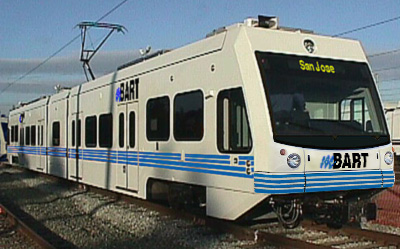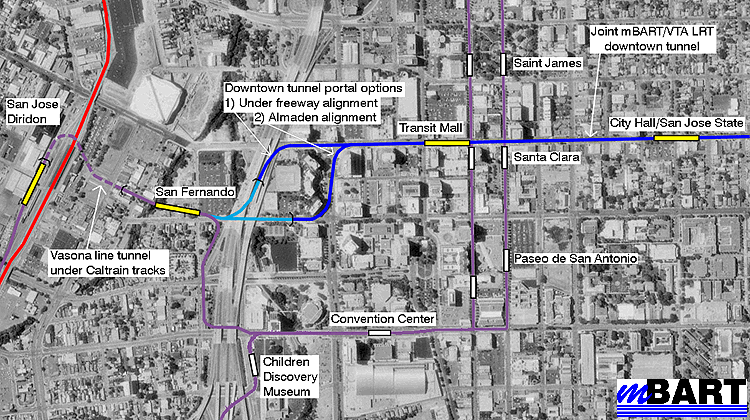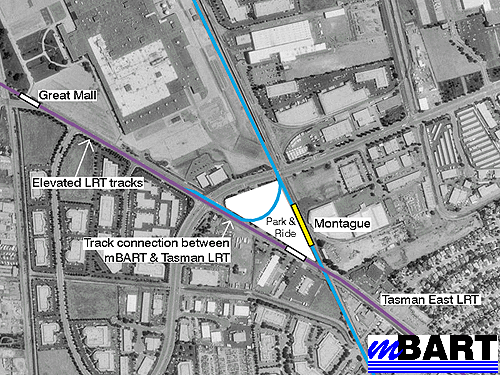If VTA actually considered, then we might have a rail connection for quite sometime now rather than still waiting for BART and VTA to settle their issues.
I used to have a separate web site for these ideas, but the advent of social media platforms and content management systems, along with changes with my hosting provider, resulted in these contents no longer appearing online.
 |
FREQUENT
By Andy Chow |
 OPERATING
CHARACTERISTICS
OPERATING
CHARACTERISTICS
Vehicles: Electric trains consist of up to six low floor light
rail vehicles, providing more than 400 seats and can accomodate about 1000
passengers standing and sitting comfortably at maximum length, significantly
higher than typical light rail trains.
Route: Connecting to BART at either Union City, Fremont, or
Milpitas via a subway under Santa Clara Street and surface alignment on
the Union Pacific rail line. The downtown subway will be shared with VTA
East-West light rail line. West of the downtown subway, which is near the
Guadalupe Freeway, mBART will make use of the Vasona LRT line into the
expanded Diridon station
Right of Way: Purchase railroad right of way from Union Pacific.
Stations: Three subway stations under Santa Clara Street. Two
surface stations west of the subway on the Vasona LRT line. The line terminates
at San Jose Diridon Station. Subway and surface stations west of the subway
will be shared with VTA East-West light rail line. Stations north of the
subway will be 1-2 miles apart for rapid service. Each station will be
constructed or upgraded to accomodate 6-car trains.
Service Frequency: 6-7 minutes peak, 15-20 minutes off-peak,
timed to meet BART trains.
Land Use Integration: Transit friendly residential and employment
opportunities around stations at least as great if not greater than other
rail modes.
Operating Model: Owned and operated by VTA with fare and schedule
coordination with BART.
Fare: Barrier-free Proof-of-Payment system, with Translink readers
for seamless connection to BART and other systems.
mBART ADVANTAGES
Compatible with light rail: mBART uses standard gauge track
and overhead electrification, permitting mBART to share tracks and stations
with VTA light rail.
Lower cost: Lower cost light rail like rolling stock and infastructure
providing speed, frequency, and capacity comparable to higher cost heavy
rail.
– The capital cost for the subway will also be lower because mBART
equipment will be able to make tighter turns than BART vehicles and thus
reduce the need to buy or obtain easement of private properties for the
rail right of way.
– mBART requires less tunneling than BART because mBART can make use
of certain portions of the surface and underground LRT right of way.
– The capital cost for the stations, especially for those on surface,
will be less because of the simpler fare collection method and the fesibility
of installing at-grade crossings.
– Resulting in additional savings by eliminating the need to provide
separate surface tracks for VTA light rail.
Greater ridership: Removing VTA East-Valley light rail from
surface mix-traffic tracks into subway significantly improves travel time
and realiability. High ridership on the underground VTA East-Valley light
rail, combining with East Bay mBART riders, help justify the high cost
of the subway construction.
Providing balanced benefits across different communities: Unlike
a BART-only subway, the subway will be shared with VTA East-Valley light
rail. Lower-income commuters traveling from East San Jose will be able
to take advantage of the traffic-free, high-speed subway service that otherwise
only higher-income commuters from East Bay will enjoy.
Smart investment: For a BART only subway to justify the ridership,
downtown San Jose will have to grow to unrealistic high level, so that
a small portion of all workers and residents will be able to use BART to
the East Bay, leaving all others from elsewhere competing for space on
surface streets. On the other hand, mBART/VTA light rail subway only require
realistic and modest growth in downtown to justify investment, and leave
fewer people using surface streets. Even if downtown San Jose were to grow
to the unrealistic level, mBART/VTA light rail subway will still have enough
capacity to accomodate the additional riders.
Providing East-West rail backbone for future LRT expansion: Without
a grade separated LRT alignment through downtown, the prospect for establishing
county wide LRT network will be greatly constrained, due to the limited
capacity on surface tracks. mBART/VTA LRT subway allows trains to operate
as close as 1.5 minutes without impacting surface traffic, and offers capacity
for future extension of LRT system on corridors such as Stevens Creek.
Medium Rail – Heavier than light rail, lighter than heavy rail:
Assuming the unrealistic high level development, in simple calculations,
which supposed that all passengers travel the whole distance and split
evenly to all trains, 4 car trains are enough to carry the ridership, and
mBART is more than ready to provide such capacity. Obviously, since not
all passengers travel the whole way and most travel during the peak period,
the actual demand for capacity may be lower, especially the during the
off-peak period. mBART can operate as short as one car trains to save maintenance
and electricity cost during low demand period. On the other hand, BART
requires a train to have at least three cars.
mBART OPTIONS:
1) Union City BART connection, no BART extension – Given that
most commuters from the East Bay reside in the Fremont, Union City, Newark
area, this option gives direct service to most East Bay riders. Also, track
connection can be provided in Milpitas between mBART and Tasman LRT for
through no-transfer service between Union City and Mountain View during
peak period, covering many employment centers in the Golden Triangle area.
2) Shinn BART connection, no BART extension – This option has
most of the advantages with the Union City connection, but also has a direct
connection with ACE and future Dumbarton Rail. A new BART transfer station
must be constructed at Shinn.
3) Fremont BART connection, no BART extension – This option
has many of the advantages with the Union City and Shinn connection, but
it will require slower operation on street median since the Fremont BART
station is not close to any existing railroad right of way.
4) Warm Springs BART connection, BART extended to Warm Springs –
This option require most commuters to transfer since mBART and BART connection
is not close to any major origin or destination.
5) Milpitas BART connection, BART extended to Milpitas – This
option provide riders connection between BART and Tasman LRT. Most East
Bay commuters have destinations in the Golden Triangle area, not downtown
San Jose. mBART provides a more cost-effective solution for the segment
with lower demand.
Detailed map of mBART alignment in downtown San Jose:

Detailed map of mBART alignment in Milpitas:

Detailed map of mBART alignment in Fremont:
